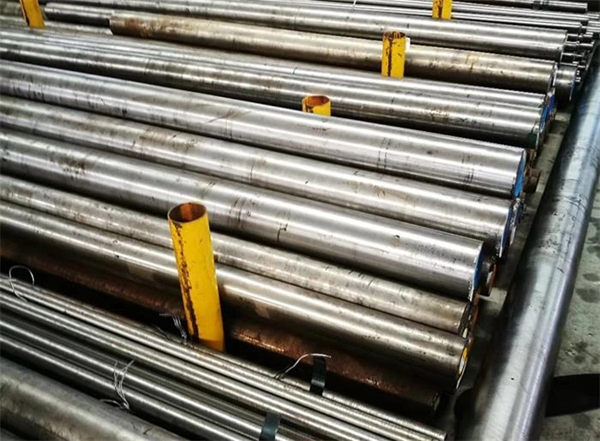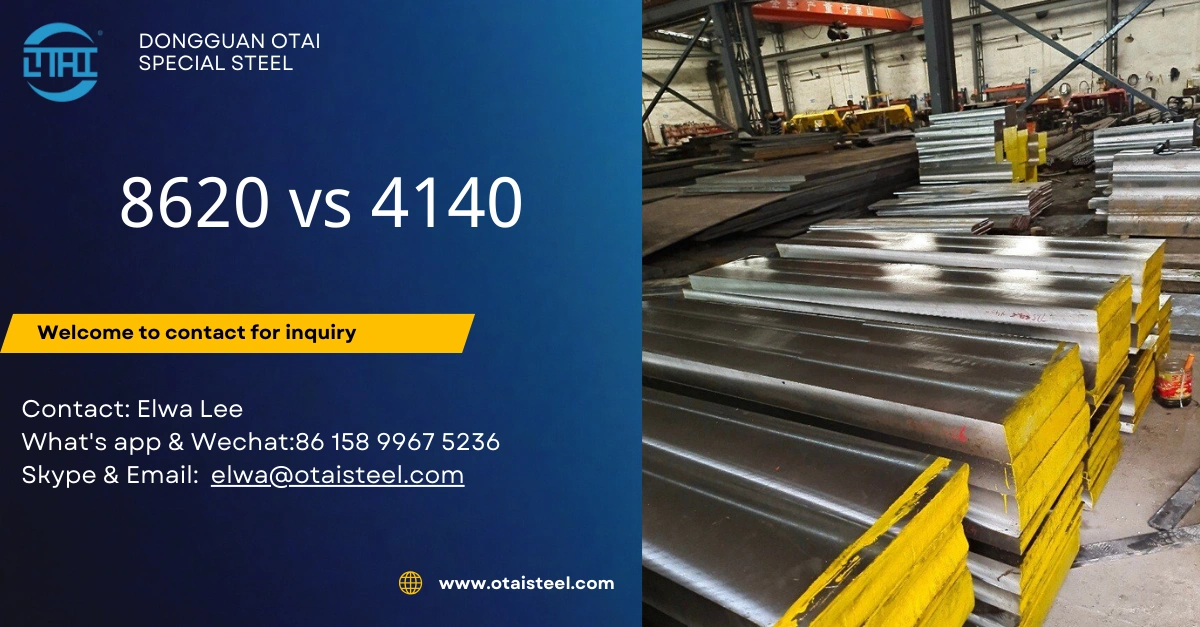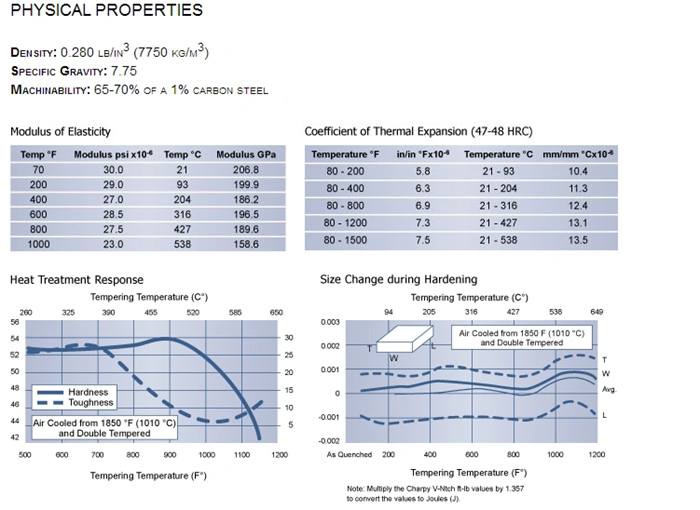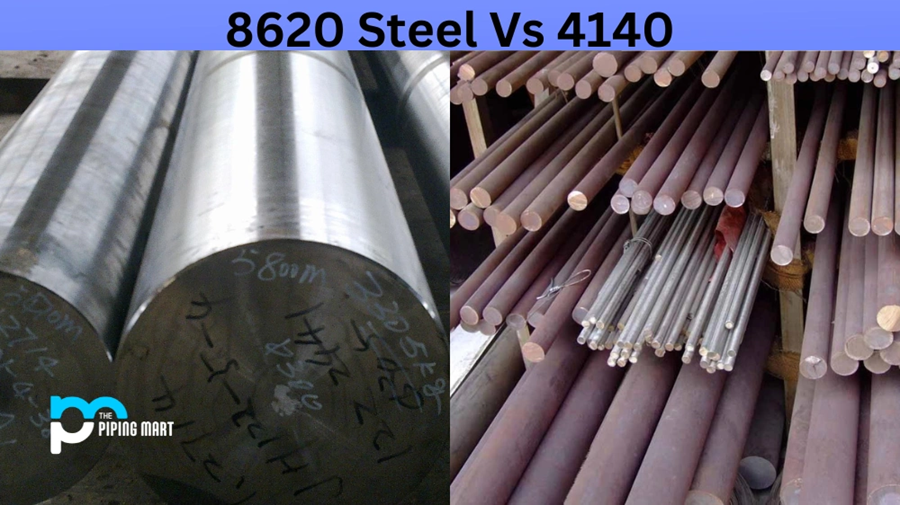
AISI 8620 steel stands out as a versatile and accessible carburizing alloy in industrial applications. The material delivers impressive mechanical performance with a tensile strength of 530 MPa (76,900 psi) and yield strength of 385 MPa (55,800 psi).
8620 alloy steel excels in corrosion and wear resistance, which makes it perfect for components exposed to harsh environmental conditions. Analysis of 8620 steel composition reveals a material with a density of 7.85 g/cm³ (0.284 lb/in³) and Brinell hardness values from 149 to 210. These mechanical properties explain why oil rigs use it extensively for drilling operations. The material’s lower melting points compared to other carbon steels influence its processing requirements and applications.
Engineers and manufacturers need to think about specific project requirements when choosing between 8620 and 4140 steel. This piece compares these two prominent alloys in different properties, processing methods, and performance characteristics to help you pick the right material for your application.
Choosing Between 8620 and 4140 Based on Project Requirements

Material properties play a key role in picking the right alloy for industrial use. Your project’s success depends on choosing between 8620 and 4140 steel based on mechanical needs and operating conditions.
When to choose 8620 for surface wear resistance
8620 steel stands out because of its case-hardening abilities. A carburizing treatment helps 8620 steel reach impressive surface hardness levels of HRC 58-62 while keeping a tough core of HRC 28-35. This creates a perfect mix – a wear-resistant exterior that protects a shock-absorbing interior.
Engineers pick 8620 alloy steel when parts need both surface durability and core ductility. Here’s where 8620 steel’s properties work best:
- Gears and transmission parts that need protection from surface wear
- Camshafts and parts that face high contact stress
- Car parts that need balanced toughness and wear resistance
- Parts you need to machine extensively before heat treatment
Heat treating through carburizing gives 8620 steel’s surface a much higher hardness than its core. Engineers call this a “tough shell, soft core” setup.
When to choose 4140 for high tensile strength
4140 steel takes a different approach by offering better overall strength throughout the part. Its tensile strength usually falls between 850-1000 MPa, and its yield strength between 655-850 MPa. This means 4140 works better than 8620 when you need uniform hardness.
4140 becomes your best bet for:
- Heavy-duty shafts and axles that deal with high torsional stress
- Parts that need consistent strength everywhere
- Machine parts handling heavy mechanical loads
- Uses where overall toughness matters more than surface wear
Project types: static vs dynamic loading
Load type guides your material choice. 4140’s uniform strength provides stability and fights deformation in static loading where parts bear steady forces.
Dynamic environments with impacts, vibration, or sudden stress changes work better with 8620’s mix of surface hardness and core flexibility. This makes AISI 8620 steel especially valuable in gearboxes, wind turbine parts, and helicopter rotor gears.
8620 shows great fatigue strength when loads keep changing. 4140, however, performs better under steady, high-stress conditions that might otherwise permanently deform the part.
Side-by-Side Comparison of Key Material Properties

These alloys have numerical differences that guide engineers to select the right materials. Looking at their mechanical, thermal, and chemical characteristics shows why each one works best in specific applications.
Tensile and yield strength comparison
A direct comparison reveals 4140 steel offers superior tensile strength from 690-1080 MPa. This is higher than 8620 steel’s 520-690 MPa. Heat-treated 4140 performs even better and reaches 1080 MPa.
The yield strength shows a similar pattern. 4140 delivers 590-990 MPa while 8620 reaches 360-570 MPa. This means 4140 can handle higher loads without permanent deformation, making it ideal for high-stress applications.
Hardness range: 8620 steel hardness vs 4140
Heat treatment responses create distinct hardness profiles in these alloys. After quenching and tempering, 4140 steel shows 28-32 HRC throughout its structure. 8620 steel’s hardness is unique – its carburized surface reaches 55-62 HRC but keeps a softer core.
The Brinell measurements tell a clear story. 4140 measures 200-310 HB while 8620 reaches 150-210 HB. This shows 4140’s greater overall hardness.
Thermal conductivity and expansion
These alloys share similar thermal properties. 4140 conducts heat slightly better at 43 W/m-K compared to 8620’s 39 W/m-K. This small difference matters in high-temperature applications.
Both materials expand at the same rate of 13 μm/m-K. This means they have predictable dimensional changes during thermal cycling.
Corrosion resistance in different environments
4140 steel’s chromium and molybdenum create a protective oxide layer that helps fight corrosion. But neither alloy matches stainless steel – they both need extra protection in harsh environments.
8620 alloy steel resists atmospheric corrosion well and handles aqueous environments, including saltwater. Yes, it is suitable for oil rig components. Both alloys still need anti-corrosion treatments in severe conditions.
Manufacturing and Processing Differences
Heat treatment plays a crucial role in shaping these two alloys’ performance in manufacturing environments. Their unique processing requirements ended up determining production efficiency, cost, and final part performance.
Heat treatment cycles: carburizing vs quenching
These alloys need different heat treatment approaches. 8620 alloy steel needs carburizing at 920°C in a carbon-rich environment. This creates a hardened case and maintains a tough core. The process continues with oil quenching at 820°C, and tempering follows at about 200°C. This achieves 58 HRC surface hardness while keeping a core hardness of 47 HRC.
4140 steel takes a different path. It goes through direct oil quenching from 845°C, which creates uniform hardness throughout. You can normalize this steel at 913°C before hardening to improve its microstructure. Best results come from tempering 4140 between 1450-1600°F to soften it, or 1550-1600°F to improve strength.
Machining behavior before and after hardening
Both alloys machine well before heat treatment. 4140 machines better than 8620 steel because of its composition. But after heat treatment, both materials become challenging to work with.
8620 steel becomes hard to grind after case hardening, and experts don’t recommend it. You should complete rough machining before heat treatment, especially with 4140 steel. This helps minimize dimensional changes.
Metal injection molding process compatibility
Metal injection molding (MIM) helps produce small, complex metal parts with tight tolerances. This process combines metal powders with polymer binders to create feedstock material for injection molding. Both alloys can work with MIM theoretically, but success rates depend on sintering behavior and shrinkage control.
Welding and forming limitations
8620 steel welds better than 4140. Preheating 8620 to 150-200°C reduces cracking risks, but some experts suggest 400°F (204°C).
4140 steel needs special care during welding because of its higher carbon content. You need to preheat it to 500°F (260°C). Post-weld heat treatment becomes necessary to prevent cracks and restore mechanical properties.
Both steels form well using conventional techniques in their annealed state. 4140 needs more force because of its toughness.
Cost, Availability, and Long-Term Performance

Money often makes the final call when choosing between steel alloys with similar technical specs. Budget limits and long-term value substantially affect how we pick materials.
Material cost per kg and sourcing
The original pricing shows a clear difference—4140 steel costs between USD 1.50 to USD 2.00 per kilogram, while 8620 steel comes at a better price. The market has plenty of 4140 steel with 2-4 week average lead times. 8620 steel isn’t quite a match for this availability and takes 3-5 weeks to arrive. Projects that need consistent metal properties will get better results with single heat lot sourcing.
Lifecycle performance in industrial use
The higher price tag of 4140 steel makes sense when you look at its superior mechanical properties. This could mean lower total ownership costs for high-performance applications.
Maintenance and reusability factors
Steel components in humid spaces need regular oil or anti-rust grease treatment to fight oxidation. 4140 steel needs extra protection in corrosive environments.
Environmental resistance and oxidation behavior
4140 steel holds up well in dry indoor spaces, but it deteriorates faster in wet or salty conditions. Both steels react with moisture and oxygen to form iron oxide that slowly eats away at the metal. These aren’t stainless steels, so they need protective treatments to survive harsh environments.
Conclusion
The choice of steel alloy can affect project outcomes by a lot, as 8620 and 4140 each bring their own strengths to specific uses. Engineers just need to look at several key differences when picking their material.
8620 steel shines when you need exceptional surface wear resistance with a tough core. This makes it a great fit for gears, camshafts, and transmission parts where surface durability stops early failure. On top of that, it welds better and machines well before heat treatment, which helps when making complex parts.
4140 steel packs more strength throughout its structure. This is a big deal as it means that the tensile and yield strength values let it handle bigger loads without warping. That’s why 4140 is the go-to choice for heavy-duty shafts, axles, and parts under constant mechanical stress.
Your project’s needs will tell you which alloy works best. Dynamic loads work better with 8620’s case-hardened profile, while static loads match better with 4140’s even strength. Heat management also plays a part, as 4140 handles heat slightly better.
Of course, cost matters when picking materials. 4140 usually costs more, but its better strength might save money over time in high-performance uses. 8620 costs less and fights corrosion just as well in many settings.
Manufacturing limits also guide your alloy choice. Both steels are tough to work with after heat treatment, but 8620’s case-hardened surface needs extra care. The welding approach differs too – 4140 needs more pre-heating and post-weld work to prevent cracks.
The best steel choice comes down to balancing performance needs against costs. The core team must review load conditions, wear resistance needs, manufacturing methods, and environmental factors before deciding. While different in makeup and properties, both 8620 and 4140 serve many industrial uses well.
Key Takeaways
Understanding the fundamental differences between 8620 and 4140 steel properties helps engineers select the optimal alloy for their specific project requirements and operating conditions.
• Choose 8620 for surface wear resistance: Excels in carburizing applications with surface hardness of 58-62 HRC while maintaining tough core flexibility for gears and transmission components.
• Select 4140 for high tensile strength: Delivers superior overall strength (850-1000 MPa) throughout entire component, ideal for heavy-duty shafts and high-stress applications.
• Consider loading type: Dynamic loading favors 8620’s case-hardened profile, while static loading benefits from 4140’s uniform strength properties.
• Factor in processing differences: 8620 requires carburizing treatment and offers better weldability, while 4140 needs direct quenching with more complex welding procedures.
• Evaluate cost vs performance: 4140 costs more initially ($1.50-2.00/kg) but may provide better long-term value for high-performance applications requiring consistent strength.
The key to successful material selection lies in matching each alloy’s unique strengths—8620’s surface durability or 4140’s overall toughness—to your specific application requirements, manufacturing constraints, and budget considerations.
FAQs
Q1. What are the key differences between 8620 and 4140 steel? 8620 steel excels in surface wear resistance with a hard exterior and tough core, making it ideal for gears and transmission parts. 4140 steel offers higher overall strength, suitable for heavy-duty shafts and high-stress applications. 8620 is more weldable, while 4140 requires special welding precautions.
Q2. For which applications is 8620 steel particularly well-suited? 8620 steel is excellent for components requiring high surface wear resistance combined with core toughness. It’s commonly used in gears, camshafts, transmission parts, and components subjected to dynamic loading or high contact stress, especially in automotive and industrial machinery.
Q3. What are the main advantages and disadvantages of 4140 steel? 4140 steel offers superior overall strength and hardness, making it ideal for high-stress applications. However, it has limitations in weldability, requiring preheating and post-weld heat treatment to prevent cracking. It also demands specific machining techniques due to its strength.
Q4. How do the heat treatment processes differ for 8620 and 4140 steel? 8620 steel undergoes carburizing at 920°C, followed by quenching and tempering, to achieve a hard surface with a tough core. 4140 steel is directly quenched from 845°C and then tempered, resulting in uniform hardness throughout the material.
Q5. What factors should be considered when choosing between 8620 and 4140 steel for a project? Consider the loading type (dynamic vs static), required surface wear resistance, overall strength needs, manufacturing processes (especially welding and machining), environmental factors, and cost. 8620 is generally more affordable, while 4140 may offer better long-term value for high-performance applications requiring consistent strength.
